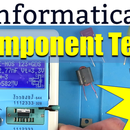Introduction: HAKKO T12 Temperature Controlled Soldering Iron Kit
How to build a Hakko T12 temperature controlled soldering iron. I show the complete build process and point out any potential problems. The video shows the build and the following steps explain the process.
The kit is available on this link : HAKKO T12 Kit
The kit does not include a power supply but I found a suitable 19 volt 3.5 Amp laptop power supply in my "packrat" hoard. Also the tip included is a knife blade which is not very useful so I also bought these 4 additional tips : T12-BC2-T12-B2-T12-BL-T12-C1-Soldering-Tips
If you are unsure which tip is right for you the Hakko website has a very good guide : Select Tip Shape
Step 1: Instructions and Documentation
The product web page gives a link to download a zip file containing the instructions and documentation. However, the instructions are a series of photos embedded in, of all things, an Excel spreadsheet! Bizarre! The documentation is in Word .docx which is also a little odd.
For folks who do not have Microsoft Office this could be a problem so I have converted the files to a more acceptable PDF format Kit Instructions PDF & "English" Manual PDF
Step 2: Controller Assembly
Before assembling the controller remove the protective film from the temperature display LED. The indicator LED has to be soldered in place, remember the positive leg of the LED is the longest and positive is marked on the PCB. Loosely fit the LED in place and offer up the controller to the front panel to see how far forward it needs to protrude through. Now you can solder it in place, use a small tipped soldering iron, you don't want to bridge the joint to any of the surrounding components. Fit the "aviation" connector to the front panel putting the indentation uppermost. Remove the protective film from both sides of the blue light filter and put in place. Put the controlled board onto the front panel and secure with washer and nut. You can now carefully solder the aviation connector in place.
Step 3: Power Supply
In the instructions there is a table showing the different voltages of power supply you can use. This affects the power the iron can produce, I chose a 19 volt supply which will power the iron up to 45 watts. The power supply was simply stuck to the base of the unit with double sided tape. I had to cut off the standoffs on the base with side cutters. The laptop power supply I have has a built in mains connector so I did not use the one supplied. I soldered the controller positive lead and the power supply positive to the switch. The negative and earth from the controller are connected together to the negative lead of the power supply. Check which is positive and negative from your supply with a multimeter.
Step 4: Connector Cable Assembly
Cut back about 25 mm of the outer sleeving from the cable. Roughly determine the length that the wires need to be when the socket is screwed together. Cut and tin the ends of the wires and also the socket pins. Finally solder the wires to the pins. slide the transparent sleeve over the connections and screw the socket into the housing. Tighten the small screws of the cable clamp. IMPORTANT! now slide the other end of the cable through the handle. Solder the vibration switch onto the element holder with the "golden" coloured lead uppermost i.e. nearest the cable. Strip and prepare the wires as before and solder to the element holder. Fix the cable to the element holder with the supplied tie wrap. Slide the element holder into the handle and locate in the grooves. Screw on the top of the handle and slide the element and tip inside. Finally slide over the ferrule and secure with the collet.
Step 5: Time to Test!
The first test is to power the controller on without the soldering iron connected. The LED temperature display should show 500. The heating LED will be off. If all is well then connect the iron. Make sure the iron is supported on something non flammable! Switch on and rotate the adjustment knob to the desired temperature, in my case 300 degrees. The iron should heat rapidly and will reach the set temperature in around 12 seconds. You may notice a little smoke coming from the tip, this is normal as the tip has been pre tinned. Test the iron with a little more solder.
Step 6: Get Soldering!!
Time to test our handywork. I just tested by soldering a header to some scrap breadboard and it worked well. Maybe so well it's time to retire my vintage Weller! There is a lot of debate as to how best to clean a soldering iron. For many years I used a damp (never wet) sponge. This works well but it does remove the solder from the tip which means retinning it every time. The wire brush method works well also and you don't need to use so much solder retinning. I have seen many "exotic" wire pads, claiming to be gold or brass, but a standard pot scourer works for me! I have tried out the other tip sizes and all work well for their intended job. In conclusion I would say this is a very good kit and makes a fine temperature controlled iron that will serve you well for many years.











